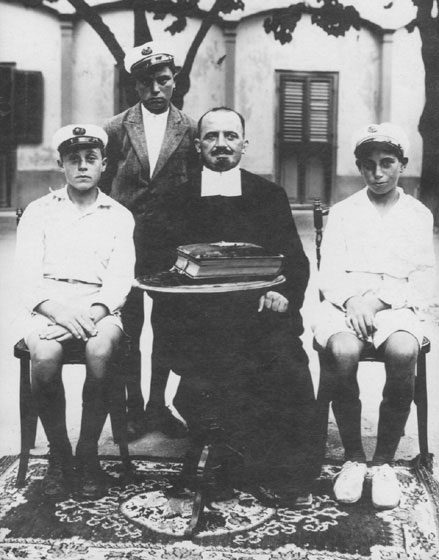
The Contributors
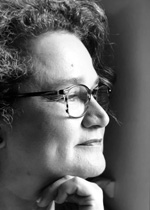
French Schools Operating in Karşıyaka (Cordelio) from their Establishment to the Republic* - Aybala Yentürk, Researcher, Writer - Türkçe
In the 19th century, most of the Western educational institutions in Izmir belonged to the French nation, and their number was more than the total number of institutions belonging to all other countries. These institutions, defined as the ‘French Schools”, were religious-based formations dominated by the French approach to education and managed by frères and sœurs.1
These educational institutions, whose main purpose was to educate Catholic communities by popularizing French in the East and to direct members of other Christian communities to their beliefs, were subsidized by the French state4 and two major religious organizations such as L’Œuvre des Ecoles d’Orient2 and Propagation de la Foi.3 The doors of French schools were open to children of all religions and nationalities, including Catholics.
These institutions, which played a major role in making French the most widely used European language in the Ottoman lands, were at first popular only among non-Muslims, but in the following years they would be effective in the transformation of Ottoman society by providing educational opportunities, especially for the children of Muslim families belonging to the upper classes.
Notre-Dame de Sion French Girls’ School of Karşıyaka
Notre-Dame de Sion was a community founded by two brothers named Théodore and Alphonse, who came from the Jewish Ratisbonne family from Strasbourg and converted to Christianity. The most important feature that distinguishes Notre-Dame de Sion, whose founding date is 1842, is when Alphonse converted to Christianity, from other Catholic communities is that it aims to remind Christians that the roots of the Bible are in the Old Testament.5 “Notre-Dame” in the name of the society refers to Mary, and “Zion” refers to the name of Jerusalem in the Old Testament. The main goal of the community was to convert Jews to Christianity; but the congregation, newly founded and not yet recognized by Rome, was poor and lacking in support. Perhaps their only hope was to privatize education in order to survive financially.6 And the community would achieve this in a short time and make its name known throughout Europe.
The Parish of Notre-Dame de Sion in Ottoman lands
The “Filles de la Charité”7, was one of the French women’s communities that first set foot on Ottoman lands, who then invited the “Notre-Dame de Sion” community, which specialized in the education of young girls, to Pangaltı in 1856, after the school they opened in Istanbul in 1841 became an institution popular with wealthy Levantine families. They handed over this schools to them. The Filles de la Charité, who set out with the motto of “reaching the poorest among the poor”, found this solution because they felt that they had moved away from their goals.8
Filles de la Charité was also an active community in Izmir, and there were educational institutions in the city dating back to the 1840s.9 As a matter of fact, the arrival of Notre-Dame de Zionists to Izmir would take place at the invitation of the Filles de la Charité in the city, just like in Istanbul. Setting out from Istanbul, Dames de Sion took over Filles de la Charité’s paid boarding schools in Izmir on 11 August 1876.10 11
Notre-Dame de Sion School is in Karşıyaka
At the Notre-Dame de Sion Boarding School in Izmir, where girls from the city’s distinguished families attend and where French language and literature dominate, language courses such as Greek, English, German, Italian, Armenian as well as music, although subject to additional fees, were offered. Painting and handicrafts lessons were also given.12 Notre-Dame de Sion School, which is remembered as one of the oldest and most famous schools in the history of education in Karşıyaka, was to be opened in 1884 as a branch of this institution in Izmir.
According to the book “concerning the number and status of foreign schools” dated 1906 in the Ottoman archives, the opening date of Karşıyaka Notre-Dame de Sion School, which was stated to have been founded by Sœur Marie Valentine, was May 15, 1884.13 As a matter of fact, Greek writer Kararas reported that the community started its education and propaganda activities in Karşıyaka in 1883.14
In a report prepared by the Izmir consul general Firmin Rougon in 1891, it was stated that the three soeur teachers qualified as teachers were educated at Karşıyaka Notre-Dame de Sion School; it was stated that two of the three classes were paid and the other was free for children of poor families.15 By 1894, the number of students in the “Ecole de Cordélio”, that is, the “Karşıyaka School”, where only day students attended, unlike the one in Izmir, reached 50. While a significant portion of these students were children of Catholic and Orthodox families, the majority of Catholic students belonged to Italian and Greek nationalities.16
In his report of 1912, which we will mention in the following lines, the journalist Maurice Pernot states that the education provided at the Karşıyaka Notre-Dame de Sion School was “l’enseignement primaire complet”, that is, a “Complete Primary Education”.17
According to the laws adopted in France in 1881-1882 that made primary education free, primary education was divided into two: “l’enseignement primaire elementaire”, “Basic Primary Education” and “l’enseignement primaire complet”, that is, “Complete Primary Education”. Basic Primary Education included morals and civic awareness, reading and writing, mathematics (four basic operations), basic geography and basic French history, physical education, military training for boys and sewing and embroidery for girls. In Full Primary Education, in addition to these courses, grammar, French literature, history (especially the history of France), some common concepts of law and political economy (home economics for girls), the fundamentals of natural sciences, physics and mathematics and their application in agriculture, hygiene and industrial sciences were taught. It included basic painting and music lessons, as well as its application to the arts, manual labour, tool use and basic crafts.18 The most important point that draws attention at this point is that Notre-Dame de Sion schools differed from other schools in terms of quality education with the “Full Primary Education” they provided.
The Notre-Dame de Sion Schools, stopped its activities like other French schools in the city with the outbreak of the First World War, and its building in Bellavista, Izmir, was used by the Izmir Dâr-ül Muallimîn Mektebi19 until the armistice.20 According to the data in a news article in Anadolu Newspaper dated December 4, 1918, the Ecole de Cordélio was also used by Karşıyaka Girls’ Numune School.21
With the signing of the Armistice of Mudros, Notre-Dame de Zion officers returned to Izmir and continued their education where they had left off. In the great fire that broke out immediately after the liberation of Izmir from the Greek occupation on September 9, 1922, the Notre-Dame de Sion School in Izmir was completely burned down, leaving only the Karşıyaka branch. Although the financial support of the Œuvre d’Orient organization continued, the amount sent was not enough to revive the schools in Izmir. Thus, the sœurs continued their educational services in the city in Karşıyaka. Dames de Sion, which received its license from the state again on November 5, 1924, entered a new era with educational opportunities and equipment that would meet the needs.22 Even though it was a painful process for them, they tried to keep up with the new regulations brought by the Republic regarding education.23
However, the French Girls’ School in Karşıyaka, under the reign of the nuns of Notre-Dame de Sion, continued its existence at Kurtuluş Street, No. 5524 until 1935, and then left its place to be used by Turkish educational institutions, leaving the stage of history completely.25
Karşıyaka Saint-Polycarpe French Boys’ School
Frères des Ecole Chrétiennes26, or “Brothers of Christian Schools”, which managed the only French boys’ school in Karşıyaka, was founded as an institute in 1680 in Reimes, France, by the theologian and priest Jean-Baptiste de la Salle, primarily to provide education to boys from tradesmen and poor families. The members of the institute consisted of frère teachers who devoted their lives with great faith to the service of education. Although the word “frère”, which means “brother” in French, was also used for Catholic priests to express “brotherhood”, the frère educators of the institute were not priests in the official service of the Catholic church and they were not called “priests”.
The Ecoles Chrétiennes were invited to the city in 1841 by the Lazarist sect27, which had already started its activities in Izmir. The primary reason behind these invitations of the Lazarists was to focus on secondary education28 by entrusting the free primary level schools they opened in Izmir to the teachers. Thus, French education in Izmir would be widespread at all levels. Following the agreement established among the community leaders and the signatures signed, the three frères set out and reached Izmir at the end of April.29 The school they took over was the first educational institution30 in the Levant, and some of the students moved to Istanbul in November of the same year.31
It was undoubtedly the Tanzimat Edict declared in the same year that gave them the courage in this regard, and they obviously did not waste much time to take action. The frères who worked as teaching assistants in their own countries, would turn into missionaries in the East. According to an inspector from the French Ministry of Education who made investigations in Izmir in 1846, the Lazarists - and of course the Frères des Ecole Chrétiennes who helped them - were aware that they could not convert children of other religions and sects to Catholicism through education. Because “this situation was very difficult or rare in the East”. “But education was a means to watch over the flock32 entrusted to their care, to ensure the slow and gentle infiltration of Catholic ideas in the future.”33
The most important feature of Frères des Ecoles Chrétiennes was that education in its institutions was completely free and at primary education level. However, this rule would be relaxed over time by opening paid classes due to financial difficulties and to raise funds to educate more poor students. Within the first years of their arrival in the Ottoman country, the Christian teachings constituted the basis of education in the schools of the frères, who followed the same education they had implemented in France. The subjects taught consisted of reading and writing, French grammar, arithmetic, history, geography and linear drawing.34 In the future, the Freers would develop their institutions according to the needs of the city and the children they addressed.
“Ecole de Cordélio” - “Karşıyaka School” opens
The schools run by Frères de Ecoles Chrétiennes when they came to the city in 1841 were primary school level institutions of the Lazarists. The frères left the Lazarists’ institution in 1853, which in a way marked the beginning of the Saint-Jean School. They founded the fee-paying Saint-Joseph College in 1881.35 They also managed the Saint - André school at the primary level, which was opened in Punta in 1881 and operated free of charge. A vocational school affiliated with this institution was opened in 1888. Their school in Karşıyaka was established as a branch of “Ecole de Cordélio” Saint-André.36
Although the Izmir French Consul General Firmin Rougon gave 188937 as the opening date of Karşıyaka School in his report, the history of the branch in question dates back a little further. According to the history38 prepared by today’s La Salle Educational Institutions, the modest branch in Karşıyaka started education right next to the Catholic church39 in 1885, and the teachers were able to move to a detached building40 only a year later.41 Two frères, who took on the task of educating the children of Karşıyaka, came from Izmir by ferry every day.
The Karşıyaka School, for which we do not have any data on the number of students in the first years of its establishment, was on the point of being closed in 1889 due to the financial burden it brought to the community. With the intervention of Izmir Consul General Firmin Rougon and the Izmir committee of Alliance Française42 by covering the travel expenses of the students who commuted between Izmir and Karşıyaka every day, the closure of the school was prevented. This support would continue the following year by providing a subscription to the ferries for 1889 with a 50% discount received from the Hamidiye Company, which operated the Gulf ferries. Seeing that the Karşıyaka School was extremely suitable for development, the consul general also ensured that the Government of the French Republic gave a subsidy of 500 francs to this institution.43 Evidently, Rougon did not see any harm in giving the date of 1889, when the danger of closure of the Karşıyaka branch was eliminated, as the establishment date in his report.
By 1891, approximately 50 students were receiving education at Karşıyaka School, where two teachers were still teaching by commuting to and from Izmir.44 By 1894, a total of 625 students from 12 different nationalities were studying in the five schools managed by the frères in Izmir (including the Karşıyaka School), and most likely among them were the children of Muslim families. In the same year, the number of students attending the school in Karşıyaka, which consisted of two classes, one of which was free, increased to 64. There were 31 students from the Ottoman Empire, mostly Greek and Armenian, and 17 students from the Greek Kingdom. The other students attending the school were 7 French, 5 Italian, 3 Austrian and one English.45 We do not have any definitive data indicating that Turkish students also received education at Karşıyaka School during this period.
The name of the branch, which was referred to as “Ecole de Cordélio”, that is, “Karşıyaka School” in most sources of the period, was Saint-Polycarpe.46
The final blow to religious orders in France’s secularization process
With the “Combes Law”, which came into force on July 7, 1904, the activities of sects and members of sects engaged in educational services within the borders of the country were completely banned by the state and their assets were confiscated. Frères des Ecole Chrétiennes was one of the main targets, and the future of the community’s schools in the East was one of the topics that preoccupied the French parliament.
However, France did not show the same radical attitude towards secularization in education as it did in its own country, for the increasing number of religious institutions in different geographies, and these schools continued their activities in the territory of the Ottoman Empire. The underlying reason for this behavior of France must be sought in its concern about losing its political competitive power and linguistic superiority over the Ottoman Empire to Britain, Italy and Germany, which it saw as rivals.
The closure of the schools belonging to religious communities in France deeply shook the frère leaders of their missions in the East. The frères who were aware that the number of personnel would increase with the influx of community members who were forced to leave their countries to Ottoman lands, were also concerned that the financial resources required to continue their duties would decrease significantly.47 In almost the same period, the Izmir Action Committee of the Alliance Française, which was of the opinion that the Karşıyaka school was a very important institution for the development and maintenance of the effectiveness of the French language since the first years of its establishment, provided them with a small amount of aid.48
Some of the 156 students studying at the paid school in 1912 were admitted to the institution free of charge, and approximately 50% of these students were Catholics and 30% were Greek Orthodox children. They were followed by Gregorian Armenian students with 15% share. Additionally, there were 7 Jewish and 4 Muslim students at the school. It is clear that some Muslim families could now easily send their children to French schools. As a matter of fact, in the same period, the total number of Muslim students attending the Frères’ schools in Izmir and Göztepe was 42.49
Years of war and occupation
The Ottoman government, which abolished the capitulations with the outbreak of the First World War in 1914, brought the educational institutions of the countries it was at war with to the brink of closure with new regulations and laws it published. At the beginning of August 1914, all of the frères under the age of forty-five in Turkey returned to their own countries, and some of them joined the war. Some of them were killed, injured or captured.50
Among the French schools that remained closed during the war was the Karşıyaka School. The frères began to return to their duties immediately after the Armistice of Mudros was signed. While the Greek occupation was continuing, the Karşıyaka School was visited by the French Cardinal Dubois, who came to Izmir as part of his extensive Eastern trip, on February 18, 1920. His Excellency, who was hosted by the Greek administration of the occupied city during his stay in Izmir, did not want to continue his trip without honouring the Catholic community and French schools in Karşıyaka with his presence.51
During the fire disaster that occurred right after the victorious end of the War of Independence and the liberation of Izmir from the Greek occupation, the most favorite institution of the Frères in Izmir, the Saint-Joseph College, was completely destroyed, leaving only the Saint-André School in Punta52 and the Karşıyaka branch.
The problem of adaptation to the new Republic of Turkey
In 1924, a total of 300 students, half of whom were Catholics, were receiving education in two schools in Izmir and Karşıyaka, which had lost all their Greek and Armenian students.53 The Karşıyaka School, a four-room, single-storey building built in 1881, was renovated in 1925.54
During the process that started with the Tevhid-i Tedrisat Law adopted on March 3, 1924, the new regulations introduced to foreign schools with the circulars issued on September 26, 1925 and February 7, 1926 put a lot of pressure on the frères. The “Law on the Entry of Turkish Citizen Children Who Will Do Their Primary Education in Schools in Turkey”, adopted by the Grand National Assembly of Turkey on March 23, 1931, was, in a sense, the beginning of the end for the frères school in Karşıyaka. It is clear that the school, which provided education at the primary level with the said law, would lose almost all of its students in the coming years. As a matter of fact, the Saint-Polycarpe French Boys’ School, which had been a part of the education life of hundreds of children from all nationalities and religions for nearly fifty years since its establishment, could only continue its existence on Karşıyaka Church Street until 1935.55
Alaybey Notre-Dame du Sacré-Cœur French Girls’ School
Karşıyaka became increasingly attractive as a settlement in the early 20th century, and its population was increasing day by day in parallel with this development. Rapid growth brought with it new needs, and education was of course at the top of these.
An active congregation founded by a young woman
Saint-Joseph de l’Apparition was founded on Christmas 1832 by Emilie de Vialar, the daughter of a wealthy family, and her three companions in the Gaillac region of France, to educate poor children and provide patient care services to the poor. The community was among the first women’s congregations of the French mission to reach foreign lands. As a matter of fact, the Saint-Josephs settled first in Algeria in 1834 and in Tunisia in 1840. In 1844 they were in Larnaca, Cyprus. Settlement in Cyprus opened the doors of the East to the sœurs, and they crossed in a short time from that island to Syria. Next was the Holy Land, where they established their home first in Jaffa and then in Jerusalem in 1849. The sœurs established their first institution in Anatolia in Trabzon in 1852. In the same year, they went to Crete and moved the community centre from Gaillac to Marseille. In 1856, when Emilie de Vialar died, the sœurs had reached as far as Australia, at the other end of the world56. The highly active community had many branches operating in Greece, Chios island, Gaziantep, Erzurum, Iskenderun, Mersin, Antakya, Giresun and Samsun.
Saint-Joseph de l’Apparition congregation in Izmir
In the early 1890s, the Saint-Joseph de l’Apparition community had a school on Chios. The sœurs opened their first and only educational institution in Izmir at house number 5, Karşıyaka Victor Street.57 The number of teachers at the school, run by Sœur Jeanne Beurel in the year it opened, was three.
One of the classes of this new school in Karşıyaka, which consisted of three classes, paid and free, was at the kindergarten level, and in this class, ethics, reading, calculus, French, gymnastics and music, as well as simple handicraft lessons were taught. In the upper grades, grammar, arithmetic, literature, general geography and history, and sewing and embroidery lessons were added to morals, reading and French lessons. In the last year of school (primary school 4th-5th grades), these courses were complemented by French spelling and composition, ancient and modern history, physics and natural science, piano and painting lessons. While Greek lessons were given for one or two hours a day in every third grade, boys up to the age of seven were also admitted to the school.58
The sœurs who visited local patients in their homes and cared for them were greatly appreciated and respected by the populace.59 In this respect, the Saint-Joseph sœurs were different from the Notre-Dame de Sion community that the people of Karşıyaka had been familiar with for years. This new community, carrying gold or silver crosses60 around their necks, was as interested in the care of the poor and the sick as they were in providing education services.
The school building is insufficient, the community moves to Alaybey
Having spent nearly four years in the house on Victor Street, the existing building of the school could no longer meet the needs. In December 1909, the community applied for permission from the Sublime Porte, through the French Consulate, to build a new school building on a large plot of land (approximately 17 acres) they purchased in Alaybey, on behalf of the new school principal, Sœur Colette.61 Although no positive response was received as a result of long correspondence, many available data show that the sœurs continued their activities in their new location in Alaybey. As a matter of fact, some data from the Republican period give the construction date of the four-room, single-storey school buildings as 1910.62
The French journalist Maurice Pernot, who visited the community on site in July 1912, described the school in his report as an institution that achieved good results and deserved to be encouraged. The report stated that the small school needed boards and desks for its free classroom that could be used in its reading and history classes. Nearly half of the 124 students at the school were Orthodox (Gregorian Armenian and Greek), while 41% were Latin and local Catholic.
In an official source belonging to the French State at the end of 1912, we see that the Saint-Joseph de l’Apparition school in Alaybey, which is stated to have 105 students, was mentioned for the first time by its name: Pensionnat63 Notre-Dame du Sacré-Cœur.64
While all the other French schools in the city were closed with the outbreak of the First World War, the sœurs did not leave their institutions throughout the war and continued to care for the poor and the sick as much as they could.65 As a matter of fact, the congregation’s dual structure as both an educational and charitable institution enabled it to remain open.
It is mentioned in the memories of Karşıyaka that the Sœur School in Alaybey, which was re-licensed on November 9, 192466, continued to provide educational services to the children of Karşıyaka during the Republican period67. Among these children, the first one that comes to mind is undoubtedly Turan Muşkara69, who recounts in his memoirs that he attended the school’s enfantine 68class. The Notre-Dame du Sacré-Cœur French Girls’ School, managed by the Saint Joseph de l’Apparition congregation, ended its educational activities in 1935.70
The chapel of Alaybey Sörler School (Saint-Joseph) was opened for worship in 1955 with the arrival of Padre Vincenzo Succi, who was appointed as the deputy abbot of the Karşıyaka Sainte-Hélène Church, and continued to serve the Catholic community of Karşıyaka until the late 80s.71
Notes:
* This text was prepared by quoting the paper of the same name presented by Aybala Yentürk at the Karşıyaka 3rd Culture and Environment Symposium, held between 24-26 November 2021.
1 In French, “frère” means brother/sister and “sœur” means nurse/sister. Frère is used for male members of religious communities and sœur for female members. Friars do not always have to be in church service, that is, “priests”. Sœurs, on the other hand, can work by devoting their lives to the service of humanity, or they can also become “nuns” by staying in monasteries and spending their lives only in prayer and contemplation. 
2 An organization established in 1856 to financially support Catholic educational institutions operating in the East (especially within the borders of the Ottoman Empire). 
3 An international association founded in Lyon in 1822 to raise funds for the missions of the Catholic Church. 
4 Ange Michel, Les Frères des Ecoles Chrétiennes en Turquie (1841-2003), Les Editions Isis, İstanbul 2004, p. 94. 
5 Saadet Özen, “Notre Dame de Sion Yüz Elli Yıllık Ders”, Toplumsal Tarih, Sayı: 145, Jan 2006, p. 75. 
6 Angela Xavier de Brito, “Comment devient-on une congréation enseignante? Le cas de Notre-Dame de Sion”, Chrétiens et Sociétés, XVIe-XXIe siècles, 25/2018, (http://journals.openedition.org/chretienssocietes/4556), access date: 12 Oct 2021. 
7 The “Charity Daughters” or the “Charity Sisters” community, also known as “Sœurs de Charité”, specialized in health, dating back to 1633. Other names were “Sœurs de Saint-Vincent de Paul”. 
8 Saadet Özen, Yüz Elli Yılın Tanığı Notre-Dame de Sion, Yapı Kredi Yay., İstanbul 2006, p. 20-21. 
9 J.B. Piolet, Les Missions Catholiques Françaises au XIXe Siècle, Tome Premier, Paris 1900, p. 143. 
12 Firmin Rougon, Smyrne, Situation commerciale et économique, des pays compris dans la circonscription du consulat général de France, Berger-Levrault et Cie. Editeurs, Paris 1892, p. 46. 
14 Νίκου Καραρά, Το Κορδελιό, το Kαμάρι της Σμύρνης· Iστορία- Λαογραφία, Eνωσις Σμυρναίων, Αθήναι 1971 [Nikou Karara, To Kordelio, To Kamari tis Smirnis İstoria – Laografia, Athens 1971], s. 116-117. 
15 Firmin Rougon, ibid, p. 46. 
16 Vitale Cuinet, ibid, p. 460. 
17 Maurice Pernot, Rapport sur un voyage d’étude à Constantinople en Egypte et en Turquie d’Asie, (Janvier-Août 1912), Typographie Firmin-Didot et Cie, Paris, 1913, p. 260. 
18 Ambroise Rendu, Code de l’enseinement primaire obligatoire et gratuit commentaire de la loi du 28 Mars 1882, A. Durand et Pendone – Lauriel, Editeurs, Paris 1883, p. 256. 
19 Boys’ Teacher Training School. 
20 Bezmi Nusret Kaygusuz, Bir Roman Gibi, İhsan Gümüşayak Matbaası, İzmir 1955, p. 137. 
21 Most likely, the Karşıyaka İnas Rüşdiyesi was meant. (It will be later become the Türkbirliği Primary School during the Republic period.) 
22 1925-1926 Ders Senesi İhsaiyat Mecmuası, p. 239. 
23 Regarding the testimonies of women from Izmir who were educated at Karşıyaka Notre-Dame de Sion school in the 1930s, see: Pelin Böke, “Karşıyaka Notre Dame De Sion Mektebi: Başka Bir Yaşam Tarzı [Karşıyaka Notre Dame De Sion School: Another Lifestyle]”, Karşıyaka 2. Kültür ve Çevre Sempozyumu 6-7-8 Kasım 2013 Bildiriler, Karşıyaka Belediyesi, İzmir, 2014, 69-87. 
24 This is the statement in a student report card from the period 1929 - 1930. 
25 Today, the Karşıyaka Gazi Anadolu High School is located in the area where this school was located. 
26 The other names were “Les Frères de la Doctrine Chrétienne”. 
27 Lazarists were a sect affiliated with the Roman Catholic Church, founded in Paris in 1625 by Saint Vincent de Paul. In 1782, at the request of the French government, the Vatican entrusted the French missions in the East to the Lazarist community. See Œuvre des Ecoles d'Orient, Bulletins Périodique, Paris, Novembre 1857, p. 1. 
28 The famous Propaganda (Sacré-Cœur) College, run by Lazarist priests in Izmir, is one of them. 
30 Œuvre des Ecoles d’Orient, Bulletin Périodique, Tome XXXI, Paris Janvier 1926-Décembre 1927, p. 40. 
32 The “herd” here is a metaphor still used today by community leaders for the communities they protect, based on the fact that Jesus was a shepherd. 
33 L’Ami de la Religion, Journal Ecclésiatique, Politic et Littéraire, Tome Cent Trentième, Librarie d’Adrien Le Clere et Cie. Paris 1846, p. 664. 
34 Félix de Conny, Les Frères des Ecoles Chrétiennes et le fondateur de leur institut, Paris 1856, p. 45. 
35 http://lasalle-po.org/presentation-du-secteur-de-turquie/ (access date: 22 Sep 2021). 
36 Firmin Rougon, ibid, p. 45. 
37 In the notebook “concerning the number and situation of foreign schools” dated 1906 in the Ottoman archives, the opening date of the school was given as 22 August 1888. See BOA, ŞD, 2757-1. 
38 http://lasalle-po.org/presentation-du-secteur-de-turquie/ 
39 What is meant by this church is the Sainte-Hélène chapel, which started to serve Catholic families from Karşıyaka in 1875. Today’s Sainte-Hélène Catholic Church is a different building located on 1728 street, the construction of which started in 1904. 
40 The building in question was located at the intersection of Church Street (1728 Street) and Aydoğdu Street (1734 Street), on the right corner when coming from the direction of the Church. The area of the single-storey school, including its garden, was 441 square meters. Until the early 2000s, the "Social Services and Child Protection Agency Izmir Community Center" was located here. See Selçuk Yaşar, Hayatım, Tükelmat A. Ş., İzmir, 1996, p. 37. 
41 According to the Greek writer Nikos Kararas, this date was October 1887, and Rome sent an aid of 2,000 francs so that the frères could construct the building. See Νίκου Καραρά, ibid., p. 117-118. 
42 Alliance Française is an international organization founded in Paris on July 21, 1883, to carry out activities to spread the French language in the colonies and abroad. The Izmir Action Committee of the organization was established on June 6, 1888, under the leadership of Consul General Firmin Rougon, and as a result of the general assembly held on the same day, Elie Guiffray was elected president. 
43 Joseph Nalpas, Jacob de Andria, Annuaire des commerçants de Smyrne et de l’Anatolie, Première Année, Smyrne 1893, p. 142-143. 
44 Annales de la Propagation de la Foi, Tome Soixante-Troisème, Lyon 1891, p. 64. 
45 Vital Cuinet, ibid, p. 459. 
46 Raphael C. Cervati, Annuaire Oriental: commerce, industrie, administration, magistrature de l’Orient, 3ème Partie, Provinces, Constantinople 1914, p. 1640. 
47 Œuvre des Ecoles d’Orient, Bulletin Périodique, Tome XXIII, Paris Janvier 1904 –Décembre 1905, p. 296. 
48 Le Grand Echo du Nord et du Pas-du-Calais de la France, 9 Mai 1905, p. 3 
49 Maurice Pernot, ibid, p. 330–331. 
51 Bulletin Réligieux de L’Archidiocèse de Rouen, No.12, Rouen, 20 Mars 1920, p. 269. 
52 When the buildings of Saint-Joseph College had completely burnt down, this educational institution was moved to the building of Saint-André School in Punta (today Izmir Private Saint Joseph French High School). 
53 Œuvre des Ecoles d’Orient, Bulletins Périodique, Tome XXX, Paris Janvier 1924-Décembre 1925, p. 278. 
54 1925-1926 Ders Senesi İhsaiyat Mecmuası, p. 238. 
55 Œuvre des Ecoles d’Orient, Bulletin Périodique, issue: 418, Paris Avril 1934, p. 49. 
56 J. Bouillat, “Émilie de Vialar (1797-1856), fondatrice des Soeurs de Saint-Joseph de l’Apparition”, Les Contemporains, Volume: 863, 1909. 
57 The meaning of the word “Victor” is not certain, although it suggests the possibility of it being today’s 1690 Street (also known as Arabacılar Street), formerly known as Zafer. Some new information obtained requires the continuing of research on a rival theory. 
59 Maurice Pernot, ibid, p. 260. 
60 According to its charter, the Saint Joseph de l’Aparition congregation had two missions: religious and social. Those who fulfilled religious missions wore a gold cross around their necks, while those who fulfilled social missions such as education, patient care and caring for the poor wore a silver cross. See J. Bouillat, “Émilie de Vialar (1797-1856), fondatrice des Soeurs de Saint-Joseph de l’Apparition”, Les Contemporains, No. 863, 1909, p. 4. 
62 1925-1926 Ders Senesi İhsaiyat Mecmuası, p. 238. 
63 “Pensionnat” means boarding school in French. 
64 Bulletin de la statistique générale de la France, Tome 4, Fascicule 2, Janvier 1915, p. 194. (It is thought that the fact that the definition of “Notre-Dame”, used for the Virgin Mary, was included in the name of the school brings about a misconception in some Turkish sources that the educational institution in question is the Alaybey branch of Karşıyaka Notre-Dame de Sion School.) 
65 Œuvre des Ecoles d’Orient, Bulletin Périodique, Tome XXXI, Paris Janvier 1926-Décembre 1927, p. 119. 
66 1925-1926 Ders Senesi İhsaiyat Mecmuası, p. 236. 
67 This is how the old timers of Karşıyaka commemorate the school belonging to the Sœurs de Saint Joseph de l’Apparition community in Alaybey. 
69 Turan Muşkara, İzmir ve Karşıyaka Anıları, Tükelmat A.Ş. İzmir 1998, p. 30. 
70 Œuvre d’Orient, Avril 1936, No.430, p. 54. The branch in Karşıyaka is not mentioned in the 1935 aid list sent to the Saint-Joseph de l’Apparition congregation in 1954. 
71 Vincenzo Rino Succi, Primo Centenaro della Chiesa di Sant’Antonio a Bayraklı, İzmir 2004, p. 43. 
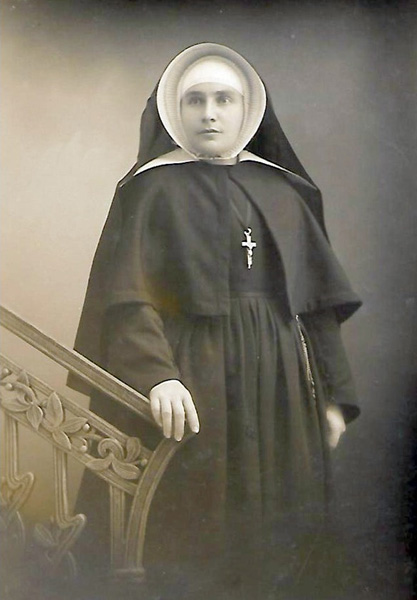
A Sœur’s habit belonging to the order of Saint-Joseph de l’Aparition.
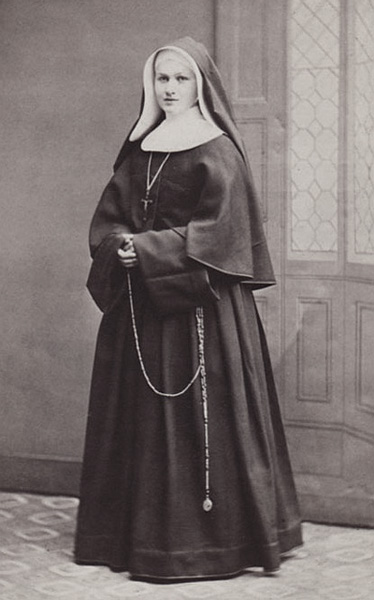
A Sœur’s habit belonging to the order of Notre-Dame de Sion.
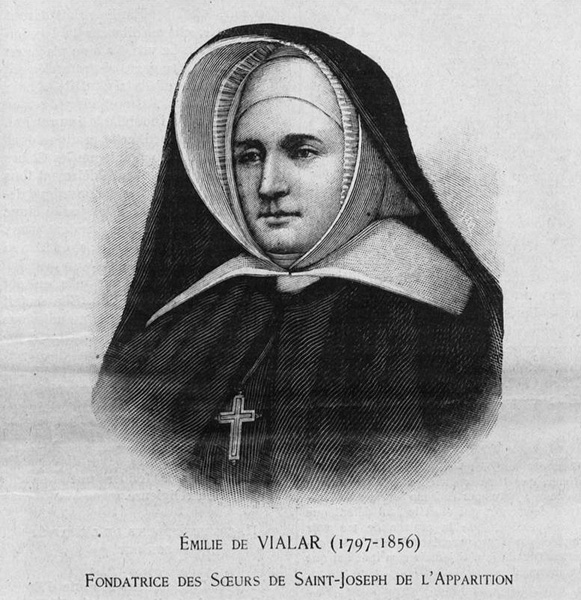
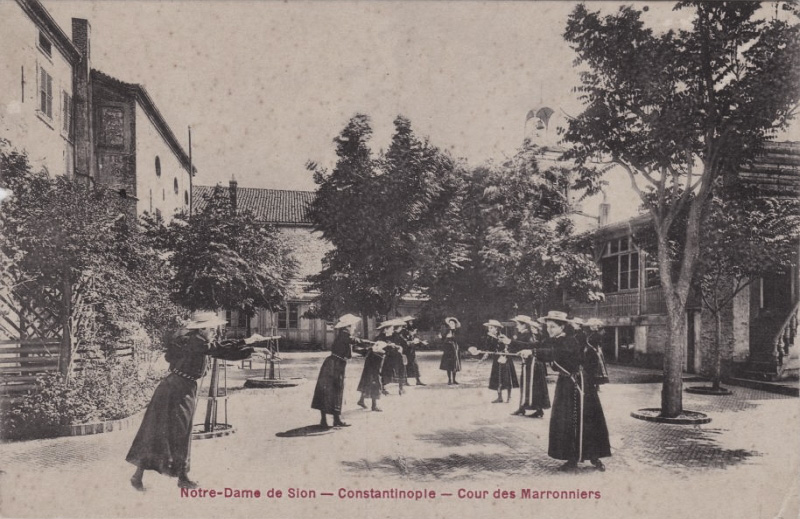
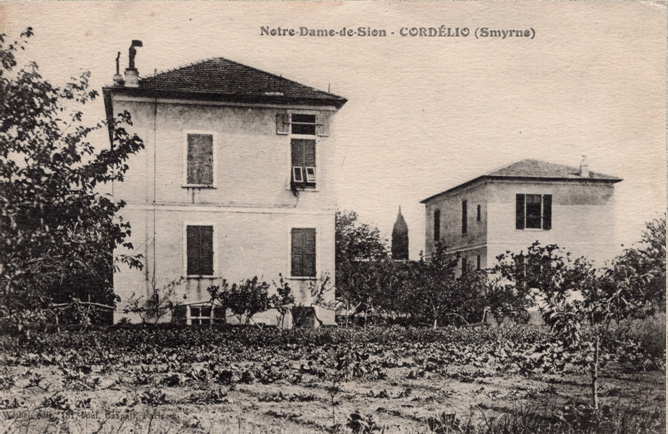
The former Notre-Dame de Sion school of Karşıyaka.
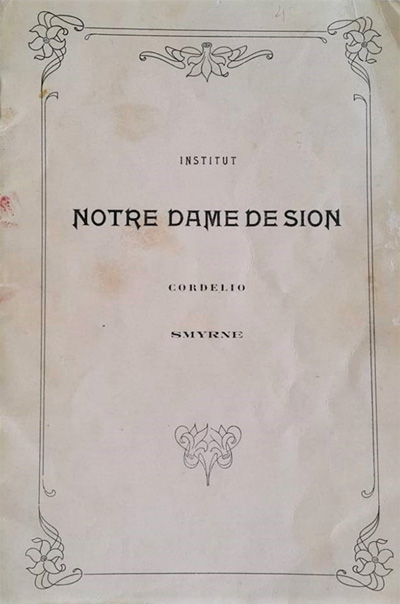
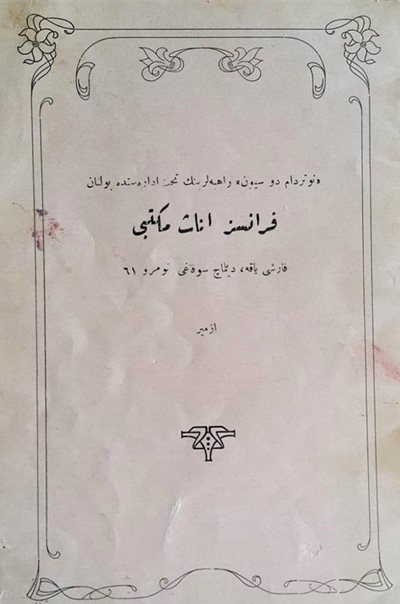
Notre-Dame de Sion Karşıyaka School, French and Turkish report card for the 1927-1928 academic year (Aybala and Nejat Yentürk Collection).
